Warm-up Before Running (Ultimate Guide)
Not sure how to warm up properly before training or race?
Would you like to reduce the risk of injury while improving your running performance at the same time?
This is the most comprehensive guide for warming up before running.
In this guide, I will explain the entire warm-up before running and show all the exercises I personally do, and those are:
- Mobility exercises and dynamic stretches
- Running drills
- Strides
So, if you would like to learn all about proper warm-up before running, this is the guide for you.
Proper warm-up before running
In this guide, I will focus on the warm-up before running, which is often neglected, but a very important segment of training.
What is a warm-up?
Warm-up is a process that gradually increases the body temperature to prepare you physically and mentally for the upcoming exertion of the main part of your training or race. Adapt it to the specific needs of the activity and focus on the muscle groups you will use the most.
Warm-up before running has to be intense enough to raise body temperature and speed up breathing but must not cause too much fatigue.
Research shows that proper warm-up results in an increase in body temperature by 2-3% which lasts for 45 minutes.
The increase in body temperature leads to useful changes in our muscles and tendons:
- Significantly boosts the elasticity of muscles and as a result, allows an exercise of higher intensity.
- Muscles and tendons become more flexible which makes stretching easier and more effective.
- Boost in enzymes and metabolic activities helps the effectiveness of muscle contractions.
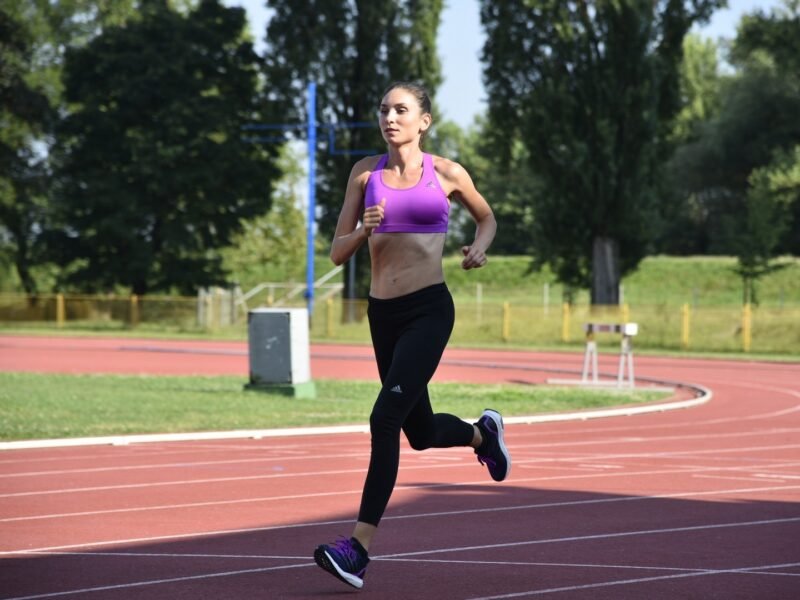
What does a proper warm-up consist of?
A complete warm-up routine before running consists of two parts, the general and the specific.
The general part of a warm-up includes:
- Easy jog or a walk – aerobic activities of low intensity (5-15 minutes)
- Mobility exercises and dynamic stretches (5-10 minutes)
The specific part of a warm-up includes:
- Running drills (5-10 minutes)
- Strides (1-8 minutes)
Tip
It is important to note that not all elements will always be included in the warm-up before running. Adapt the warm-up to the type of training or race!
In the following text, I will show you a detailed overview of the exercises you can use during warm-up.
Mobility exercises and dynamic stretches
Mobility exercises prepare joints for activities that require better mobility or are more demanding than common, everyday movements.
Joint rotations lubricate joint cartilages and help the secretion of more synovial fluid, which reduces friction and makes movement easier.
They are designed to improve the functional range of motion of your joints while increasing muscle strength and flexibility.
Read more: Top 15 Mobility Exercises For Runners [Video]
Dynamic stretches are controlled and repeat specific motions that imitate the movement of your muscles and connective tissue during activities.
Studies have shown there are several benefits of dynamic stretching: increased flexibility, raised heart rate, increased blood flow, raised body temperature, and the preparation of your body for an efficient run.
Read more: Top 20 Dynamic Stretches For Runners [Video]
List of mobility exercises and dynamic stretches
Mobility exercises and dynamic stretches should start with the outer parts of the body and move inwards while going from head to toe, or in the opposite direction.
Perform each exercise within the limits of comfort, and do not make any sudden movements.
Maintain your posture, keep your upper body straight, and do not bend your back.
1. Neck rotation
Neck rotation is an exercise that improves neck mobility and helps remove pain and stiffness in the neck while stretching neck muscles.

- Start by standing with your feet hip-distance apart, look straight ahead, and put your hands on your hips to keep your upper body straight.
- Turn your neck left and look over your left shoulder, then turn right and look over your right shoulder. Repeat the motion 5 times.
- Bend your neck forward, then side to side. Repeat the motion 5 times.
- Bend your head left, then right, Repeat the motion 5 times.
2. Arm circles
Arm circles are an exercise that improves shoulder mobility by stretching and strengthening the muscles of the shoulder.

- Start by standing with your feet hip-distance apart, look straight ahead, and keep your upper body straight.
- Raise your left arm and make circular motions.
- Make 5 circular motions in both directions.
Repeat the exercise with your other arm.
3. Torso rotation
Torso rotation is an exercise that activates your core by stretching and strengthening the external oblique muscles, chest muscles, and back muscles.
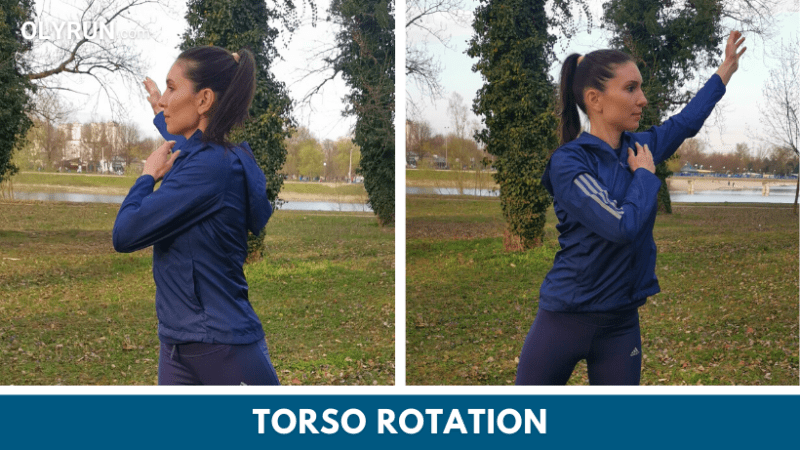
- Start by standing with your feet hip-distance apart, look straight ahead, and keep your upper body straight.
- Swing your left arm to the left, following it with your eyes. Put your right arm on the shoulder of the stretched arm.
- Swing your right arm to the right, following it with your eyes. Put your left arm on the shoulder of the stretched arm.
Repeat the motion 5-10 times.
4. Standing side bend
The standing side bend is an exercise that stretches and strengthens abdominal muscles, activates your upper body, and improves your stability and posture.

- Start by standing with your feet hip-distance apart, put your hands on your hips, look straight ahead, and hold your body upright.
- Raise your left arm and bend to the right. Maintain the position for 3 seconds.
- Return to the starting position.
- Raise your right arm and bend to the left. Maintain the position for 3 seconds.
Repeat the motion 5 times.
5. Hip circles
Hip circles are one of the hip mobility exercises that improve hip mobility while stretching lower back muscles and strengthening the core.

- Begin by standing with your feet hip-distance apart, hands on your hips, look straight ahead, and keep your upper body straight.
- Move your hips in a circular motion.
Do 10 reps of circular motions in both directions.
6. Standing forward bend
The standing forward bend stretches your hamstrings and the lumbar area while activating your upper body.

- Start by standing with your feet hip-distance apart, look straight ahead and hold your body upright.
- Raise both your arms and bend forward, trying to touch your feet.
- Maintain the position for 5 seconds and return to the starting position.
Repeat the motion 5 times.
7. Straight leg swings
Straight leg swings are one of the hip mobility exercises that improve the mobility of hip flexors and extensors. They also activate the nervous system, which prepares you for a faster run.
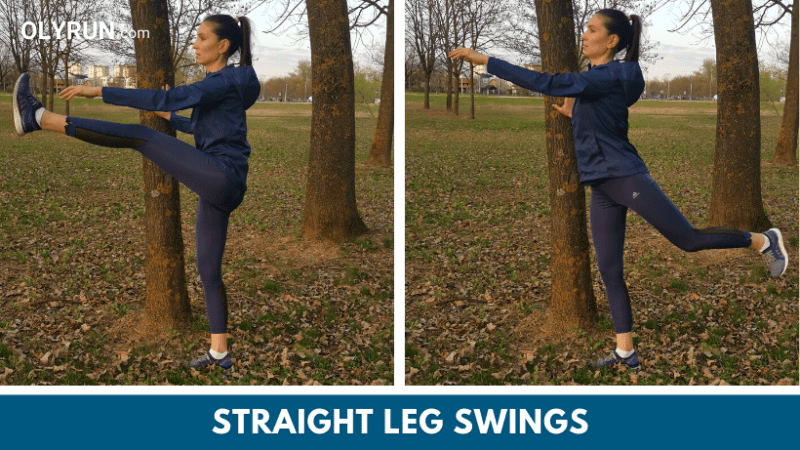
- Stand next to your support (fence, tree, bench…) and hold it for balance during the exercise.
- Swing the left leg, stretched in the knee, forward then backward, standing fully on the right foot as you swing.
Do 10-15 reps, then repeat the exercise with the opposite leg.
8. Side leg swings
Side leg swings are one of the hip mobility exercises that improve the mobility of the hip adductors and abductors.
These are the muscle groups used to move your leg toward or away from the midline of your body.

- Stand in front of your support (fence, tree, bench…) and hold it for balance during the exercise.
- Swing the left leg, stretched in the knee, to the left, and then to the right, standing fully on the right foot as you swing.
Do 10-15 reps, then repeat the exercise with the opposite leg.
9. Standing knee to chest
Standing knee to chest is one of the hip mobility exercises that improve hip mobility while increasing the flexibility of the glutes and the hamstrings.

- Begin by standing with your feet hip-distance apart, look straight ahead, and keep your upper body straight.
- Raise the left knee to the chest, standing fully on the right foot.
- Grab the raised knee with both hands, pulling it closer to the chest. Hold the position for 5-10 seconds.
- Slowly lower the left leg on the ground.
Do 10 reps, then repeat the exercise with the opposite leg.
10. Heel grab
Heel grab is one of the hip mobility exercises that improve the mobility of your hips and ankles while also stretching your groin.

- Begin by standing with your feet hip-distance apart, look straight ahead, and keep your upper body straight.
- Grab the left heel with both hands and pull it towards the opposite hip, standing fully on the right foot. Hold the position for 5-10 seconds.
- Slowly lower the left foot to the ground.
Do 5-10 reps alternately with each leg.
11. Standing quad stretch
Standing quad stretch is an exercise that improves hip and ankle mobility, and stretches the quadriceps, hip flexor muscles, and the tibialis anterior.

- Start by standing with your feet hip-distance apart, look straight ahead, and keep your upper body straight.
- With both of your hands, pull your left heel towards the glutes, standing fully on your right foot. Hold the position for 5-10 seconds.
- Slowly lower your left foot to the ground.
Repeat the motion 5-10 times with each leg.
12. Single-leg hip rotation
Single-leg hip rotation is one of the hip mobility exercises that improve hip mobility and strengthen the glutes and the hamstrings, while also activating your core.

- Begin by standing with your feet hip-distance apart, look straight ahead, and keep your upper body straight.
- Lift the left knee up to the hips, standing fully on the right foot.
- Move the left leg in a circular motion.
Do 10 reps in both directions, then do the exercise with the opposite leg.
13. The world’s greatest stretch
The world’s greatest stretch is one of the hip mobility exercises that improve hip mobility, stretch hip flexors, and your groin while strengthening your glutes.
That allows you to have longer stride length and better movement control.
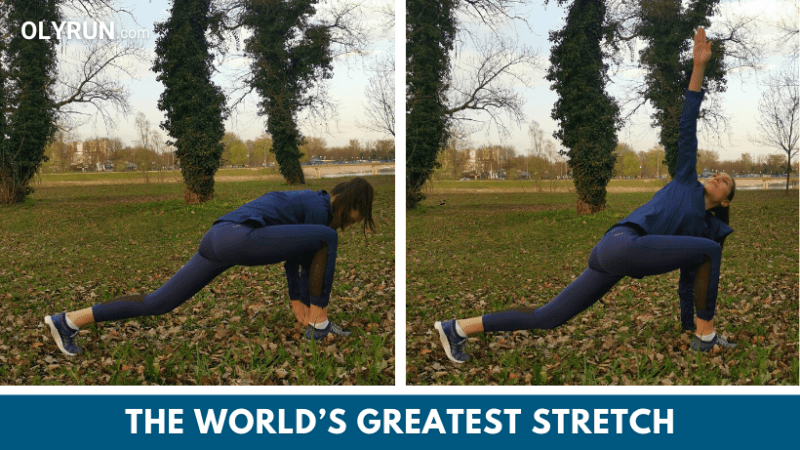
- Begin by standing with your feet hip-distance apart, look straight ahead, and keep your upper body straight.
- Step forward with the left foot into a lunge. Put both of your palms on the ground, parallel to the left foot.
- The left elbow should be as close to the ground as possible.
- Extend the left arm upwards, following it with your eyes.
Repeat the motion 3-5 times, then repeat with the opposite side.
14. Hamstring sweep
The hamstring sweep is a dynamic exercise that helps improve the flexibility of your hamstrings by stretching and relaxing the muscles.

- Begin by standing with your feet hip-distance apart, look straight ahead, and keep your upper body straight.
- Step forward with your left foot, with your weight on your heel.
- Bend forward and swing your arms so that you can feel the hamstrings tightening.
Repeat the exercise 5-10 times, while switching sides.
15. Dynamic calf stretch
Dynamic calf stretch is an exercise that helps improve ankle mobility by stretching the hamstrings and calves while strengthening calves, core, arm, shoulder, and feet muscles.

- Start with both of your palms and feet on the ground.
- Raise your left heel and put your right leg on the back of your left leg.
- Slowly lower your left heel towards the ground until you feel the slight tightening in your left calf muscles.
Repeat the motion 5 times and then repeat the exercise with the opposite side.
16. Ankle Circles
Ankle circles is an ankle mobility exercise that relaxes the ligaments and tendons around the ankle.
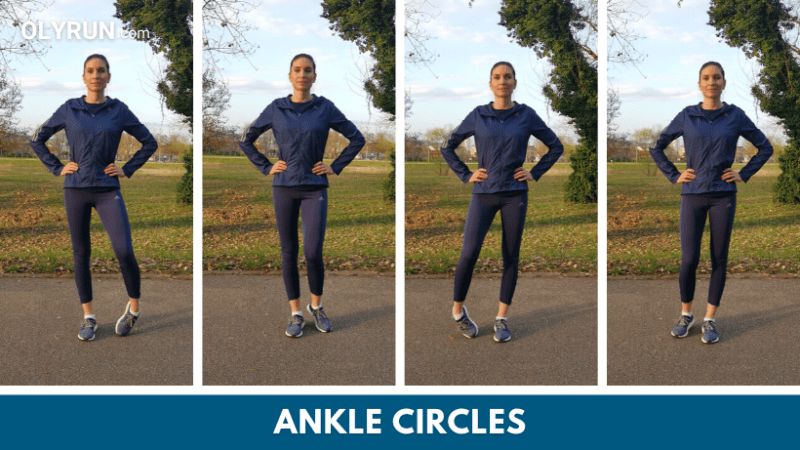
- Begin by standing with your feet hip-distance apart, look straight ahead, and keep your upper body straight.
- Do circular motions in the ankle of your left foot, leaning on your right foot.
- Do 10 circular motions in both directions.
Repeat the exercise with the other foot.
17. Dynamic hurdler stretch
The dynamic hurdler stretch improves hip flexibility and mobility by stretching the glutes, hamstrings, and hip abductors.
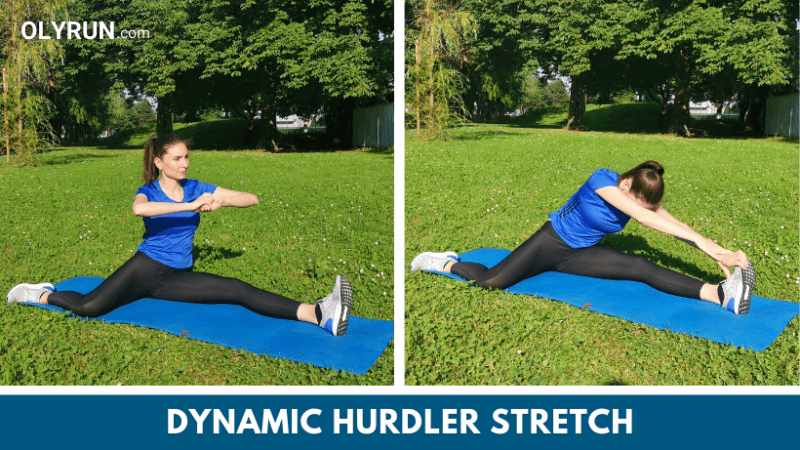
- Start by sitting, with your left leg stretched forward, and your right leg bent in the knee at a 90-degree angle. Also, your right leg should be at a 90-degree angle in relation to your left leg.
- Bend forward towards the stretched leg to feel the glutes and the hamstrings tightening. Maintain the position for 2-3 seconds.
- Return to the starting position.
Repeat the motion 5 times and then repeat the exercise with the opposite side.
18. Dynamic seated single-leg hamstring stretch
The dynamic seated single-leg hamstring stretch is an exercise that improves hip flexibility and mobility by stretching the glutes, hamstrings, and hip adductors.
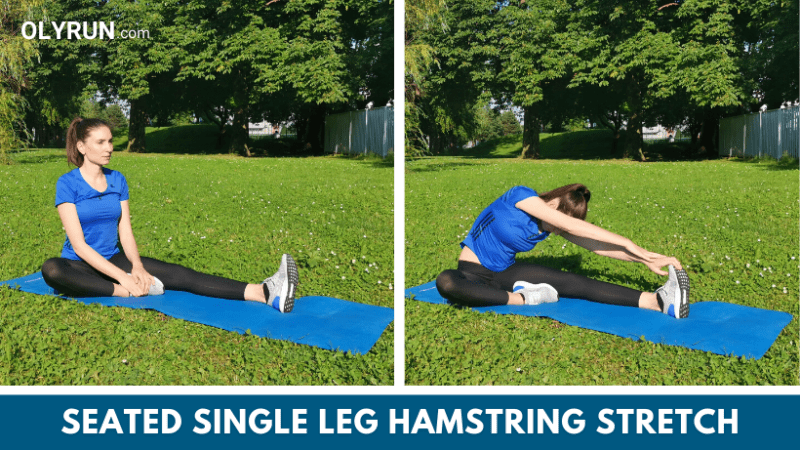
- Start by sitting, with your left leg stretched forward, and your right leg bent in the knee with your right foot on the inner side of the opposite thigh.
- Bend forward towards the stretched leg to feel the glutes and the hamstrings tightening. Maintain the position for 2-3 seconds.
- Return to the starting position.
Repeat the motion 5 times and then repeat the exercise with the opposite side.
19. Dynamic butterfly
The dynamic butterfly is one of the hip mobility exercises that improve hip mobility, and stretch your groin, and hip adductors.

- Sit in the starting position with your hands holding your feet together, knees spread out.
- With your elbows, apply light pressure to your knees, pushing them as close to the ground as possible. Repeat the motion 5 times.
- Hold the position for 10 seconds in the maximum range of motion.
20. 90/90
90/90 is one of the hip mobility exercises that improve hip mobility, and stretch hip abductors and abductors while strengthening the glutes.

- Start by sitting with your legs at a 90-degree angle, and both should be bent at the knee at a 90-degree angle.
- Lean forward so that you can feel your hips stretching. Hold the position for 5 seconds.
- Return the body to the original position and repeat the motion 5 times.
Repeat the exercise with the opposite side.
Running drills
Running drills are dynamic movements that help warm up muscles and prepare joints used in running.
In addition to warming up, running drills also:
- Develop proper technique while improving the running economy
- Increase cadence (number of steps per minute)
- Reduce contact with the ground
- Develop neuromuscular effectiveness – improve communication between nerves and muscles
- Improve coordination, agility, and balance
- Strengthen hip flexors, core, and leg muscles
- Reduce the risk of injury
- Improve cardiovascular condition
- They do not require any equipment
Read more: Why Running Drills Are Important? [9 Reasons]
List of running drills
1. Ankling
Ankling activates your feet, improves your coordination, and develops the strength and mobility of your ankle.
It also helps to develop the proper landing mechanics of a run, while increasing cadence, which makes you a faster and more efficient runner.
- Begin by standing with your feet hip-distance apart, look straight ahead, and keep your upper body straight.
- Step forward with your right foot and land on the ball of your foot while standing on your left leg.
- Shift your weight from your left to your right leg by transferring the weight from the ball of your foot to the heel so that each part of the foot comes in contact with the ground.
- Continue alternating sides and moving forward.
- Make your steps quick and small. Your arms should follow your leg movements, as they do during a run.
Make your steps quick and small. Your arms should follow your leg movements, as they do during a run.
2. High knee march
High knee march is a simple running drill in which you raise your knees high, maintain an upright posture and proper foot placement as you run, as well as improve the coordination of arms and legs.
Also, the high knee march is an excellent starting point for beginners from which they can progress towards more complex running drills, such as A-skip or high knees.
- Begin by standing with your feet hip-distance apart, look straight ahead, and keep your upper body straight.
- Step with your left foot by raising your knee to hip height while standing on your right leg.
- Lower your left foot below your center of mass.
- Raise your right foot and repeat the movement.
- Continue alternating sides and moving forward.
Your arms should follow your leg movements, as they do when you are running. As you are doing the high knee march your foot should be bent towards your shin (dorsiflexion).
3. A-skip
A-skip helps maintain proper posture, teaches you to raise your knees, and improves your neuromuscular efficiency, as well as arm-leg coordination.
Also, it teaches proper foot placement during a run.
- Begin by standing with feet hip-distance apart, look straight ahead, and keep your upper body straight.
- Raise your left leg to hip height while skipping on the ball of your right foot.
- Hit the ground below your center of mass with the ball of your left foot and stand on both feet.
- Continue alternating sides and moving forward.
Your arms should follow your leg movements, as they do when you are running.
As you are doing the A-skip your foot should be bent towards your shin (dorsiflexion).
4. High knees
High knees improve the strength of the front part of your feet, as well as arm-leg coordination.
It also increases your cadence and teaches you to reduce contact with the ground.
- Begin by standing with your feet hip-distance apart, look straight ahead, and keep your upper body straight.
- Raise your left leg to hip height while standing on the ball of your right foot.
- Hit the ground below your center of mass with the ball of your left foot while raising your right leg to hip height.
- Continue alternating sides and moving forward.
Your arms should follow your leg movements, as they do when you are running.
As you are doing the high knees your foot should be bent towards your shin (dorsiflexion).
5. B-skip (paw-back)
B-skip (paw-back) teaches you to raise your knees properly and grip the surface during a run.
It also improves coordination and flexibility of your hamstrings, and it increases the range of motion of your hips and ankles.
- Begin by standing with your feet hip-distance apart, look straight ahead, and keep your upper body straight.
- Raise your left leg to hip height while skipping on the ball of your right foot.
- Explosively grab the ground with your left leg so that the ball of your foot hits the ground below your center of mass, standing on both of your feet.
- Continue alternating sides and moving forward.
Your arms should follow your leg movements, as they do when you are running.
As you are doing the B-skip your foot should be bent towards your shin (dorsiflexion).
6. Straight leg bounds
Straight leg bounds teach you to actively engage the ground from your feet.
It also develops proper contact with the ground so that you do not overstride.
Finally, it activates your hamstrings and improves arm-leg coordination.
- Begin by standing with your feet hip-distance apart, look straight ahead, and keep your upper body straight.
- Stretch your right leg forward, while bending your knee as little as possible.
- Pull your right leg below your center of mass and emphasize the explosive contact of the ball of your foot with the ground, while stretching your left leg forward.
- Continue alternating sides and moving forward.
Your arms should follow your leg movements, as they do when you are running.
As you are doing the straight leg bounds your foot should be bent towards your shin (dorsiflexion).
7. Butt kicks
Butt kicks strengthen your hamstrings and glute muscles while increasing the flexibility of your quadriceps by imitating overemphasized leg swings, occurring after the foot loses contact with the ground.
- Begin by standing with your feet hip-distance apart, look straight ahead, and keep your upper body straight.
- Pull the heel of the right foot toward the buttocks while standing on the ball of your left foot.
- With the ball of your right foot hit the ground below your center of mass and at the same time pull the heel of the left foot toward the buttocks.
- Continue alternating sides and moving forward.
Your arms should follow your leg movements, as they do when you are running.
As you are doing the butt kicks your foot should be bent towards your shin (dorsiflexion).
8. Carioca drill
Carioca drill teaches you to move your legs starting from your hips as you run, while also improving your hip mobility.
It also activates your feet while improving coordination and agility.
- Stand sideways to the direction you will be moving in, with your legs parallel to your shoulders, and keep your upper body straight.
- Cross your right foot in front of your left and shift your weight to the ball of your right foot.
- Move your left foot to the side until you have returned to your starting position.
- Cross your right foot behind your left and shift your weight to the ball of your right foot.
- Move your left foot to the side.
Maintain balance with your hands and the arms should follow the leg movements.
Repeat the motions and move to your left until you cross the goal distance, and then move to the opposite side.
Read more: Top 8 Running Drills To Improve Your Form [Video]
How to do running drills?
Out of the mentioned running drills, you should pick 2 or 3.
Do each drill over 20 to 40 meters. After each drill walk back to your starting position.
Repeat each running drill 2 to 3 times.
Example
2 x 20m high knee march
2 x 20m A-skip
2 x 20m high knees
Also, you can do running drills continuously, one after another.
Pick 3 drills and switch to the next one every 20 meters. After each set, walk back to your starting position. Repeat 2-3 times.
Example
2 x 60m (20m ankling, 20m high knees, 20m butt kicks)

When should you do running drills?
Running drills should be done before the main part of more intensive training or race, as part of your warm-up routine, or after easy training.
It is important to be rested so that you can more easily focus on the proper execution of the drills.
If you do them poorly, you will ruin your running technique, and as a result, increase your risk of injury.
Tip
If you are a beginner, running drills should be performed under a trainer’s supervision. If that is not an option, ask another runner to observe you, or record yourself so that you can see whether you are performing the exercise properly.
Running strides
Running strides are gradual accelerations at distances between 60 and 100 meters. They are done from a completely slow pace to 90 percent of your maximum speed.
Strides can be done by beginners and advanced runners, regardless of whether you run long or short distances.
How to do running strides?
Start slowly and then gradually increase your tempo up to the speed where you can run with proper technique – a fast, but controlled tempo.
Running strides are done from 60 to 100 meters.
After each stride, walk back to the starting position or rest in place. Adjust the distance and number of running strides to the training and your abilities.
Tip
Running pace is not important. Do not compete with yourself or anyone else. Running strides are not separate training, but an exercise that helps develop speed and prepare you for fast running with proper technique.
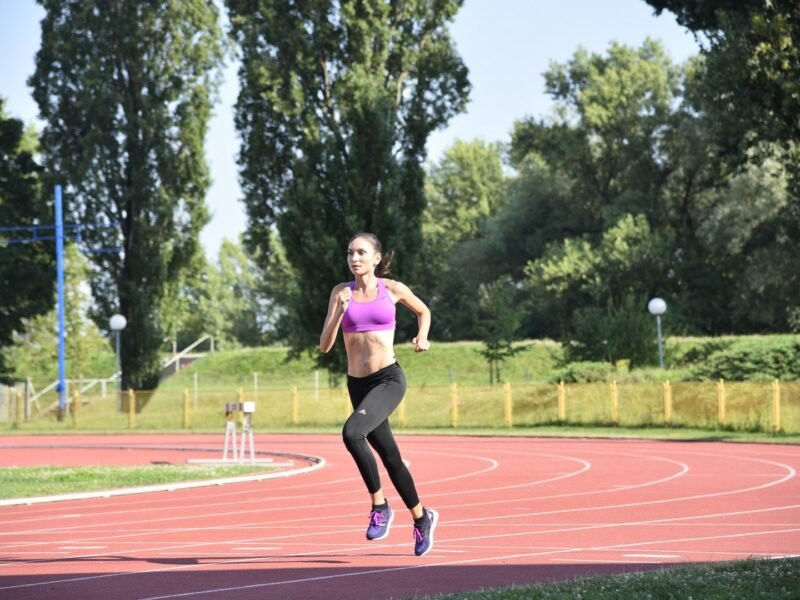
When to do running strides?
Running strides should be part of your warm-up before more intensive training, such as intervals or tempo training, or before a race.
Likewise, it is good to do them immediately after an easy training, in preparation for the next day’s intensive training.
Before you start doing strides, warm up with 10-15 minutes of easy jogging, and then do mobility exercises and dynamic stretches.
It is important that you warm up but still be rested and fresh enough to focus on proper running technique.
Why should you do running strides?
Running strides have numerous benefits:
- They prepare the body for more intensive training or race – help you to get used to the feeling of a faster run.
- They activate fast-twitch muscle fibers after long and easy training – it is enough to do several running strides to refresh your tired legs after a long run.
- They help break up the monotony – allow you to incorporate faster running into your training plan without sacrificing the entire training.
- They improve the running economy– lasting just 15 seconds, they allow you to completely focus on a proper running technique in a short period.
- They improve your neuromuscular coordination – by improving communication between your nerves and muscle fibers, you will be better coordinated, and your muscles will be better prepared for more intensive training or a race.
- They are short and can be done anywhere – they last for only a couple of seconds and you can do them anywhere, under the condition that you have enough space.
Read more: What Are Running Strides And How To Do Them?

My warm-up routines before running
I will show you my warm-up routines before every type of training or race.
It is important to mention that there is no one correct approach to warm-up that would work for everyone.
Develop your own warm-up routine, while keeping in mind your fitness level, the type of training or race, the weather, and the time you have available.
Tip
Listen to your body and experiment with exercises and warm-up length to see what would fit you best.
My warm-up routines before training
Each type of training requires its own warm-up routine. The shorter and more intensive the training, the longer and more complex the warm-up should be. On the other hand, the longer and easier the training, the shorter and simpler the warm-up.
Warm-up before long run (15 minutes)
- Mobility exercises and dynamic stretches (5 minutes)
- An easy jog for the first 10 minutes, then gradually accelerate up to the goal tempo.
Warm-up before interval training (23-40 minutes)
- Easy jogging (10-15 minutes)
- Mobility exercises and dynamic stretches (5-10 minutes)
- Running drills (5-10 minutes)
- Strides – 2-3 x 60m (3-5 minutes)
Warm-up before tempo training (20-25 minutes)
- Easy jogging (10 minutes)
- Mobility exercises and dynamic stretches (5-7 minutes)
- Strides – 2-3 x 100m (5-8 minutes)
Warm-up before uphill running (15 minutes)
- Easy jogging (10 minutes) on even terrain
- Mobility exercises and dynamic stretches (5 minutes)
- First uphill run of lower intensity
Warm-up before fartlek (15-20 minutes)
- Mobility exercises and dynamic stretches (5 minutes)
- Easy jogging (10-15 minutes)

Warm-up routine before a race
Each type of race requires an adjusted warm-up routine.
As I have previously emphasized, the rule is – the shorter the races, the longer and more complex the warm-up.
Tip
As you train, try different things to figure out what suits you best. The race is no place to experiment! Use warm-up routines similar to the ones you used during training. This way you reduce stress before the race by focusing on what is already known. It will also be easier to prepare yourself for the upcoming mental exertion.
Warm-up before 5 km and 10 km races (25-40 minutes)
- Easy jogging (10-15 minutes)
- Mobility exercises and dynamic stretches (5-10 minutes)
- Running drills (5-10 minutes)
- Strides – 3 x 60m (5 minutes)
Warm-up before a half marathon (27-30 minutes)
- Easy jogging (10 minutes)
- Mobility exercises and dynamic stretches (5-7 minutes)
- Running drills (5-6 minutes)
- Strides – 3 x 100m (7 minutes)
Warm-up before a marathon (13-20 minutes)
- Easy jogging (5-10 minutes)
- Mobility exercises and dynamic stretches (5-7 minutes)
- Strides – 2 x 100m (3 minutes)
Read more: Warm-up Routine Before Running (Training/Race)

FAQ – Frequently Asked Questions
Why is it important to warm up before running?
Properly performed warm-up before a run has numerous benefits:
1. Prepares the body for the upcoming exertion by increasing body temperature and speeding up breathing and heart rate
2. Increases muscle oxygen supply and prevents the accumulation of lactic acid
3. Improves metabolism and raises muscle temperature, which increases agility
4. Improves running economy
5. Reduces risk of injury
6. Increases alertness and focus
7. Improves performance
Should I always warm up before running?
You need to warm up before every run, regardless if it is easy training or an important race. Besides reducing the risk of injury, the warm-up will also prepare you for the activity and improve your performance.
Should I always do the complete warm-up before running?
A complete warm-up is not always necessary. It should be adjusted according to the type of training or race.
If you’re preparing for a long run, start with mobility exercises and dynamic stretches. Then, ease into a light jog for the first 5 minutes, and gradually increase the speed until you reach the goal tempo for your training.
However, if you are preparing for more difficult training (such as intervals) then it is desirable to do a complete warm-up:
1. Easy jogging
2. Mobility exercises and dynamic stretches
3. Running drills
4. Strides
Before shorter races, the warm-up is longer and more complex, which means that before a 5 km race, you should do a complete warm-up routine.
Before longer races, the warm-up is shorter, which means that before a marathon you should do an easy jog of 10 minutes, mobility exercises, dynamic stretches (5-10 minutes), and 1-2 x 100 meters of strides.
How long does a warm-up before a run last?
Warm-up before a run lasts, on average, between 20 and 45 minutes, but it depends on several factors:
1. Fitness level – the better the runner’s condition, the more time he needs to warm up.
2. Age – on average, older people need more time to warm up.
3. Training intensity – the harder the training, the more time you need for a warm-up, while for easier training a shorter warm-up is enough.
4. Race length – the longer the race, the longer and more complex the warm-up.
5. Weather conditions – the body warms up with more difficulty at lower temperatures, so warm-up will take more time in winter than in summer. During colder times, body temperature should be maintained with warm clothing.
How intense should a warm-up before a run be?
Warm-up needs to be intense enough to raise body temperature and speed up breathing, but it should not exhaust you. Gradually increase the intensity of your warm-up until you reach the level of exertion close to the exertion of a run. The total intensity of a warm-up should not go over the anaerobic threshold.
How soon before a race should I finish a warm-up?
Finish your warm-up as close to the start of the race as possible. The effect of warming up is short – Research has shown that you lose the benefits of a warm-up after 45 minutes because muscle temperature returns to its original level.
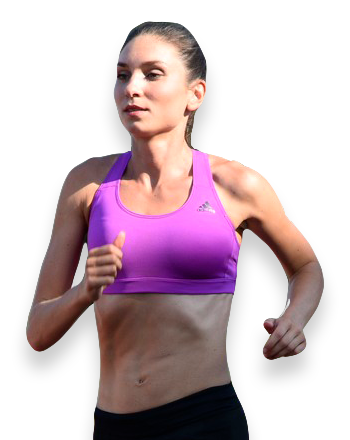
Matea Matošević
Hi, I’m Matea! I’m an Olympic Marathon Runner, founder, and writer behind OLYRUN.com. On this site, I provide help in the form of my knowledge and experience to all who love running and active living. Read more…
